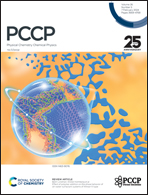Structures of multinuclear U(vi) species on the hydroxylated α-SiO2(001) surface: insights from DFT calculations†
Abstract
Multinuclear U(VI) species may be dominant in aqueous solutions under environmental conditions, while the structures of the multinuclear U(VI) species on mineral surfaces remain unclear. This work reports the structural and bonding properties of the possible surface complexes of three aqueous multinuclear U(VI) species, i.e., (UO2)2(OH)3+, (UO2)2(OH)22+ and (UO2)3(O)(OH)3+, on the hydroxylated α-SiO2(001) surface based on density functional theory (DFT) calculations. The results show that (UO2)2(OH)22+ and (UO2)3(O)(OH)3+ tend to form end-on structures at ![[triple bond, length as m-dash]](https://www.rsc.org/images/entities/char_e002.gif) SiO(H)SiO(H) sites, whereas (UO2)2(OH)3+ prefers a side-on structure at
SiO(H)SiO(H) sites, whereas (UO2)2(OH)3+ prefers a side-on structure at ![[triple bond, length as m-dash]](https://www.rsc.org/images/entities/char_e002.gif) SiO(H)O(H)-SiO(H)O(H) sites. The main driving forces for the formation of the multinuclear U(VI) surface complexes are electrostatic interactions and partially covalent chemical bonds. The Os-2p orbital hybridizes strongly with U-5f and U-6d orbitals, with a decreasing binding strength in the sequence of (UO2)2(OH)3+ > (UO2)2(OH)22+ > (UO2)3(O)(OH)3+ for the adsorption at the same type of surface sites. For the adsorption of the same multinuclear U(VI) species, the binding energy increases with the deprotonation extent of the identical sites. In addition, hydrogen bonds between surface hydroxyls and coordination waters as well as the acyl oxygen of uranyl moieties contribute to the formation of the multinuclear U(VI) surface complexes. The U-5f electron delocalization of far-side U atoms in the end-on structures of (UO2)2(OH)22+ and (UO2)3(O)(OH)3+ surface complexes also contributes slightly to the overall binding energy. Overall, this study provides insights into the adsorption behavior of multinuclear U(VI) on silica.
SiO(H)O(H)-SiO(H)O(H) sites. The main driving forces for the formation of the multinuclear U(VI) surface complexes are electrostatic interactions and partially covalent chemical bonds. The Os-2p orbital hybridizes strongly with U-5f and U-6d orbitals, with a decreasing binding strength in the sequence of (UO2)2(OH)3+ > (UO2)2(OH)22+ > (UO2)3(O)(OH)3+ for the adsorption at the same type of surface sites. For the adsorption of the same multinuclear U(VI) species, the binding energy increases with the deprotonation extent of the identical sites. In addition, hydrogen bonds between surface hydroxyls and coordination waters as well as the acyl oxygen of uranyl moieties contribute to the formation of the multinuclear U(VI) surface complexes. The U-5f electron delocalization of far-side U atoms in the end-on structures of (UO2)2(OH)22+ and (UO2)3(O)(OH)3+ surface complexes also contributes slightly to the overall binding energy. Overall, this study provides insights into the adsorption behavior of multinuclear U(VI) on silica.



 Please wait while we load your content...
Please wait while we load your content...